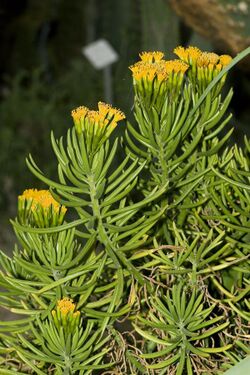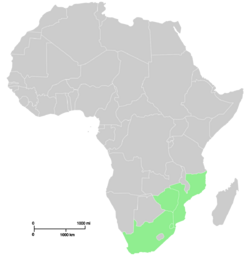Biology:Senecio barbertonicus
| Senecio barbertonicus | |
|---|---|

| |
| Barberton groundsel | |
LC (SANBI)[1]
| |
| Scientific classification | |
| Kingdom: | Plantae |
| Clade: | Tracheophytes |
| Clade: | Angiosperms |
| Clade: | Eudicots |
| Clade: | Asterids |
| Order: | Asterales |
| Family: | Asteraceae |
| Genus: | Senecio |
| Species: | S. barbertonicus
|
| Binomial name | |
| Senecio barbertonicus Klatt[2]
| |

| |
| Range of Senecio barbertonicus. | |
Senecio barbertonicus, the Barberton groundsel[3] or succulent bush senecio,[4] is an evergreen succulent shrub of the family Asteraceae and genus Senecio, native to Southern Africa,[2] named after one of its native localities Barberton and is now also being cultivated elsewhere for its drought resistance, clusters of sweetly scented,[4] golden-yellow, tufted flower heads in winter and attractiveness to butterflies,[3] the painted lady butterfly (Vanessa cardui) in particular.[5]
Description
A succulent bush growing over 2 m (6 ft) tall and wide with a fleshy trunk, light green, cylindrical, finger-like leaves 5 to 10 cm (2 to 4 in) in length and 6 to 10 mm (1⁄4 to 3⁄8 in) in diameter, densely packed around the stem and curved at the base to lie parallel to the stem and pointing upwards.[6]
The fragrant yellow flowers, 1 cm (3⁄8 in) wide and 8 cm (3 in) long, bloom July through September,[4] are terminal and produce seeds with a dense tuft of bristles.
Senecio barbertonicus is hardy to at least −4 °C (25 °F).[5]
Distribution
Senecio barbertonicus grows predominantly in rocky grassland and bushveld in Southern Africa in areas ranging from Eswatini and Mozambique, to Eastern parts of Zimbabwe and South Africa [4] at elevations between 34 and 1,700 m (110 and 5,500 ft).[7]
It is locally common in protected areas in eastern, central, and southwestern Eswatini[8] in Gauteng, KwaZulu-Natal, Limpopo, Mpumalanga and North-West.[7]
Gallery
-
Fruiting flower heads
-
Mature bush
References
- ↑ "Threatened Species Programme | SANBI Red List of South African Plants". http://redlist.sanbi.org/species.php?species=3152-41.
- ↑ 2.0 2.1 The Southern African Botanical Diversity Network (2006-01-20). "Final Swaziland Tree ATlas index". http://www.sabonet.org.za/downloads/35_swaziland_tree_atlas/j.swazi.index.pdf.
- ↑ 3.0 3.1 The Friends of U.C. Riverside Botanic Gardens (2007-10-20). "SHRUBS". http://www.gardens.ucr.edu/events/shrubsFall.html.
- ↑ 4.0 4.1 4.2 4.3 Carruthers, Vincent (2005). "Wild Flowers". The Wildlife of Southern Africa: A Field Guide to the Animals and Plants of the Region. Struik. pp. 310 pages. ISBN 1-86872-451-4. https://books.google.com/books?id=QygFIjP9jYUC&pg=PT248. Retrieved 2008-02-27.
- ↑ 5.0 5.1 "Senecio barbertonicus - Succulent Bush Senecio". San Marcos Growers Web Site. http://www.smgrowers.com/products/plants/plantdisplay.asp?plant_id=3121.
- ↑ "Senecio barbertonicus Klatt". Swaziland's Flora Database. South African National Botanical Institute (PRECIS database) and the Swaziland National Herbarium. http://www.sntc.org.sz/flora/speciesinfo.asp?spid=3331.
- ↑ 7.0 7.1 "Senecio barbertonicus Klatt". African Flowering Plants Database. Conservatoire et Jardin botaniques de la Ville de Genève and South African National Biodiversity Institute, Pretoria. http://www.ville-ge.ch/cjb/bd/africa/details.php?langue=an&id=98011.
- ↑ The Southern African Botanical Diversity Network. "SABONET Tree Atlas Report No. 38". Swaziland Tree Atlas. http://www.sabonet.org.za/downloads/35_swaziland_tree_atlas/b.swazi.aster-celastra.pdf.
Further reading
- Wild Flowers of KwaZulu-Natal - Elsa Pooley (Natal Flora Trust, Durban 1998) ISBN:0-620-21500-3
- "The Succulent Senecios of South Africa". The Guide to Life, The Universe and Everything. 2003-07-13. http://www.bbc.co.uk/dna/h2g2/A1107857.
Wikidata ☰ Q13952587 entry
 |



